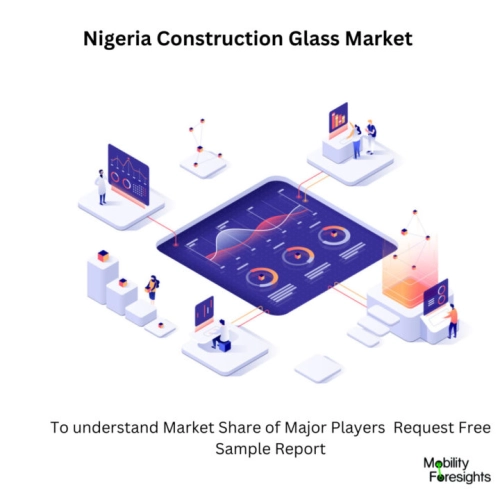
- Get in Touch with Us

Last Updated: Apr 25, 2025 | Study Period: 2023-2030
Glass has been a fascinating material to humans since its inception.Glass has come a long way since it was supposed to have magical abilities.It is one of the most flexible and oldest construction materials available.Its significance in architecture has developed throughout time, from humble origins as a window pane in luxury houses in Pompeii to complex structural elements in new era buildings.
Modern architecture has been essential in the mass manufacturing of concrete, glass, and steel buildings in the factories they call cities since its inception.This idea aided in meeting the housing demands of the growing middle class.Glass and steel architecture have become emblems of growth in many nations, as people associate these structures with wealth and luxury.
Glass is a brittle, rigid material that can be clear or translucent. The glass manufacturing technique of fusing. Sand is fused with lime, soda, and other admixtures in this process, then rapidly cooled. Glasses used in engineering for building and architectural applications.
The result is a homogeneous slurry of molten glass. This mixture is then floated on molten tin to make the necessary thickness of glass. The glass is set to cool when the hot end of the operation is completed. The strength of the glass is determined by how it is cooled. It must be cooled after maintaining a proper temperature, i.e. annealed.
The key quality of glass that permits viewing of the outside world through it is transparency. Glass can be transparent from both sides or from one side alone. Glass operates like a mirror from one side transparency to the other. The modulus of rupture value of glass determines its strength. Glass is a fragile material in general, but by adding admixtures and laminates, they may make it stronger.
Glass may be molded into any form or blown during the melting process. As a result, the workability of glass is a great feature.Visible transmittance is the visible proportion of light that passes through glass.The quantity of heat passed through glass is represented by the U value.
Float glass is made of sodium silicate and calcium silicate, and it is also known as soda-lime glass. Because it is transparent and flat, it produces glare. Float glass is used in a variety of applications, including storefronts and public spaces.Shatterproof glass is used for windows, skylights, and flooring, among other things.
In the manufacturing process, a form of plastic known as polyvinyl butyral is used. As a result, when it breaks, it cannot produce sharp-edged pieces.Laminated glass is made up of layers of regular glass.
As a result, it is heavier than a regular glass. It is thicker and more resistant to UV and sound. These are utilized in aquariums, bridges, and other structures.Photocatalytic and hydrophilic qualities distinguish extra clean glass. Because of these features, it is stain resistant and has a lovely look.
Chromatic glass is used in ICUs and conference rooms because it controls the transparency of the glass and shields the interior from sunlight. Photochromic glass has light sensitive lamination, thermos-chromatic glass has heat sensitive lamination, and electrochromic glass has electric lamination over it.Tinted glass is simply coloured glass.
To generate coloured glass that does not alter the other qualities of glass, a color creating element is put into the usual glass mix. Toughened glass is a tough, low-visibility glass. It comes in all thicknesses and, when broken, generates minute granular bits that are harmful. Tempered glass is another name for this. This sort of glass is utilized in fire-resistant doors, mobile screen protectors, and other applications.
Glass blocks or glass bricks are made from two separate halves that are crushed and annealed together during the glass melting process. These are employed for architectural purposes in the building of walls, skylights, and other structures. When light passes through them, they provide an aesthetically pleasing look.
Glass wool is a filler composed of glass fibers that works as an insulator. It is made of fire-resistant glass.Insulated glazed glass units are made up of two or three layers of glass that are separated by air or vacuum. Because of the air between the layers, they do not allow heat to pass through and serve as good insulators. Double glazed units are another name for them.

TheNIgeria Construction Glass Market accounted for $XX Billion in 2022 and is anticipated to reach $XX Billion by 2030, registering a CAGR of XX% from 2023 to 2030.
Egi MJG Float Glass, a partnership of the Egi Community, Mara Group, JS Group, and Ghani Group, announced the groundbreaking for their first float glass production factory in Nigeria.
The Rivers State production plant plans to manufacture tonnes of float glass per day for a wide range of applications ranging from architectural solutions to the automobile sector.The entire project investment will be during the first phase and an extra amount during the second extension phase.
This project is a first step towards making Nigeria self-sufficient in glass manufacture. They are convinced that they will be able to establish a world-class, cost-competitive plant due to the strategic location and locally accessible raw materials.
Given the continent's expanding need, this factory might be the first of several facilities developed and maintained by the joint venture, laying the groundwork for a West African glass manufacturing industry. Nigeria has no local float glass production capacity and is therefore heavily reliant on imports from Europe, South America, and China. Simultaneously, domestic demand is expanding due to the country's thriving housing sector, and tonnes per year are now predicted.
Egi MJG Float Glass is a joint venture between the Mara Group, a multi-sector conglomerate with activities in African countries, and the JS Group, an industrial conglomerate with stakes in Asia, the Middle East, and Africa. The Ghani Group, a glass maker with factories in India, is also a partner in the joint venture.
| 1 | Market Segmentation |
| 2 | Scope of the report |
| 3 | Abbreviations |
| 4 | Research Methodology |
| 5 | Executive Summary |
| 6 | Introduction |
| 7 | Insights from Industry stakeholders |
| 8 | Cost breakdown of Product by sub-components and average profit margin |
| 9 | Disruptive innovation in the Industry |
| 10 | Technology trends in the Industry |
| 11 | Consumer trends in the industry |
| 12 | Recent Production Milestones |
| 13 | Component Manufacturing in US, EU and China |
| 14 | COVID-19 impact on overall market |
| 15 | COVID-19 impact on Production of components |
| 16 | COVID-19 impact on Point of sale |
| 17 | Market Segmentation, Dynamics and Forecast by Geography, 2023-2030 |
| 18 | Market Segmentation, Dynamics and Forecast by Product Type, 2023-2030 |
| 19 | Market Segmentation, Dynamics and Forecast by Application, 2023-2030 |
| 20 | Market Segmentation, Dynamics and Forecast by End use, 2023-2030 |
| 21 | Product installation rate by OEM, 2023 |
| 22 | Incline/Decline in Average B-2-B selling price in past 5 years |
| 23 | Competition from substitute products |
| 24 | Gross margin and average profitability of suppliers |
| 25 | New product development in past 12 months |
| 26 | M&A in past 12 months |
| 27 | Growth strategy of leading players |
| 28 | Market share of vendors, 2023 |
| 29 | Company Profiles |
| 30 | Unmet needs and opportunity for new suppliers |
| 31 | Conclusion |
| 32 | Appendix |